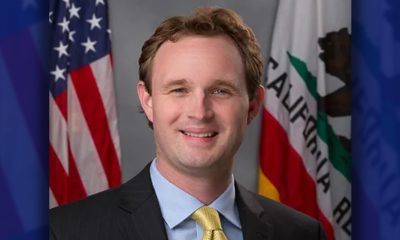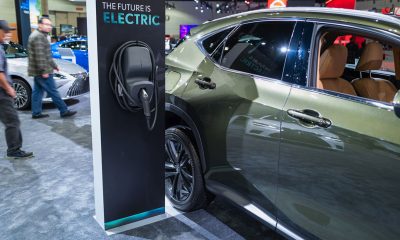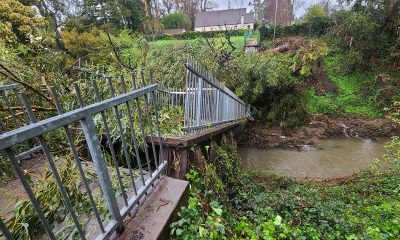Environment
San Leandro Opens Three Electric Vehicle Charging Stations for Public Use
The City of San Leandro announced that it has installed three new electric vehicle (EV) charging stations that are now available for public use.
Two of the stations are located at the City’s Downtown Garage, located at 122 Estudillo Av., and the third station is located at the City’s Wastewater Treatment Plant at 3000 Davis St.
“Electric vehicles ultimately save money for those who drive them and are good for the environment because these vehicles don’t directly generate any carbon emissions,” said Mayor Pauline Russo Cutter. “But one of the biggest impediments to more people being able to own these types of vehicles is finding a place to charge them.”
The stations have been installed as part of a wider effort known as the Bay Area Charge Ahead Project, a grant program funded by the California Energy Commission that is facilitating the installation of 152 EV charge ports throughout the Bay Area in high-priority areas.
In order to use the stations, members of the public need only to drive up and plug in (a Charge Point account is required). Users will be charged $1.50 per hour for the first four hours of charging, and $5.00 per hour thereafter. The Charge Point Level 2 stations provide power between 208 to 220 volts, which typically provide a full vehicle charge within four hours.
The Bay Area Charge Ahead Project is part of a regional collaboration being led by the California EV Alliance and its partners, including the Bay Area Climate Collaborative, a program of Prospect Silicon Valley.
“The Bay Area is the nation’s leading regional electric vehicle market on a per capita basis,” added Richard Schorske, executive director of the California EV Alliance. “Reaching our regional goal of 100,000 electric vehicles on the road by 2020 will result in over $100 million going into the local economy that would otherwise be spent on petroleum products coming from outside our region.”
There are nearly 40,000 plug-in vehicles and 2,500 charging spots in the Bay Area. Electric vehicle sales have grown steadily in California, exceeding the rate of adoption compared to conventional hybrids when first introduced.
In 2014, electric vehicles accounted for over five percent of auto sales, and are expected to grow according to state and independent projections. Battery costs, which are the most significant component of electric vehicle costs, are also estimated to decrease by up to 50% or more by 2020.
The increased use of electric vehicles will also help San Leandro achieve its Climate Action goals because these cars serve to reduce greenhouse gas emissions and produce less noise pollution. Electric vehicles also emit only 20 percent of the heat that is generated by conventional automobiles, which can help to cool down Bay Area cities during warm summer months.
For more information, contact Judy Walker of the San Leandro Department of Public Works at (510) 577-3437.
Activism
LIVE! — TOWN HALL ON RACISM AND ITS IMPACT — THURS. 11.14.24 5PM PST
Join us for a LIVE Virtual Town Hall on the Impact of Racism hosted by Post News Group Journalist Carla Thomas and featuring Oakland, CA NAACP President Cynthia Adams & other Special Guests.
Thursday, November 14, 2024, 5 p.m. – 6:30 p.m. PST

Join us for a LIVE Virtual Town Hall on the Impact of Racism hosted by Post News Group Journalist Carla Thomas and featuring Oakland, CA NAACP President Cynthia Adams & other Special Guests.
Thursday, November 14, 2024
5 p.m. – 6:30 p.m. PST
Discussion Topics:
• Since the pandemic, what battles have the NAACP fought nationally, and how have they impacted us locally?
• What trends are you seeing concerning Racism? Is it more covert or overt?
• What are the top 5 issues resulting from racism in our communities?
• How do racial and other types of discrimination impact local communities?
• What are the most effective ways our community can combat racism and hate?
Your questions and comments will be shared LIVE with the moderators and viewers during the broadcast.
STREAMED LIVE!
FACEBOOK: facebook.com/PostNewsGroup
YOUTUBE: youtube.com/blackpressusatv
X: twitter.com/blackpressusa
Business
Gov. Newsom Issues Executive Order to Tackle Rising Electric Bills
Gov. Gavin Newsom has issued an executive order to help alleviate the financial burden of skyrocketing electric bills on residents. This directive instructs the state’s Public Utilities Commission (PUC) and Energy Commission to identify strategies to lower electricity costs and prevent rapid increases in the future.

By Bo Tefu, California Black Media
Gov. Gavin Newsom has issued an executive order to help alleviate the financial burden of skyrocketing electric bills on residents. This directive instructs the state’s Public Utilities Commission (PUC) and Energy Commission to identify strategies to lower electricity costs and prevent rapid increases in the future.
Among the key actions proposed, the governor emphasized a closer examination of utility expenditures related to wildfire mitigation, which accounts for about 13% of residential electric bills.
Newsom underscored the state’s commitment to balancing affordability with environmental goals.
“We’re taking action to address rising electricity costs and save consumers money on their bills,” said Newsom. “California is proving that we can address affordability concerns as we continue our world-leading efforts to combat the climate crisis.”
California now has the second-highest electric rates in the country, trailing only Hawaii, with residential bills having surged as much as 110% over the past decade. The largest utilities, including Pacific Gas & Electric, Southern California Edison, and San Diego Gas & Electric, have seen rate hikes of 20% to 50% in just the last three years, approved by the state’s regulatory bodies.
The executive order also directs the California Air Resources Board (CARB) to explore increasing the California Climate Credit, which provides some relief on energy costs for residents. Additionally, the PUC is urged to pursue federal funding opportunities to further reduce electric expenses.
While consumer advocates welcomed the governor’s focus on lowering costs, concerns were raised regarding potential cuts to essential clean energy programs. CALPIRG, a consumer group, pointed out that the real issue behind high utility bills is wasteful spending by utilities and urged greater accountability.
Bay Area
California Ports to Receive Over $1 Billion in Federal Funds to Decarbonize
Last week, U.S. Senator Alex Padilla (D-Calif.) announced that the Environmental Protection Agency (EPA) will allocate over $1 billion to seven California ports for zero-emission (ZE) infrastructure and climate management plans. In an Oct. 29 press release, Padilla said this funding, part of the EPA’s Clean Ports Program and supported by the Inflation Reduction Act, aims to reduce greenhouse gas emissions and improve air quality at ports nationwide.

By Bo Tefu, California Black Media
Last week, U.S. Senator Alex Padilla (D-Calif.) announced that the Environmental Protection Agency (EPA) will allocate over $1 billion to seven California ports for zero-emission (ZE) infrastructure and climate management plans.
In an Oct. 29 press release, Padilla said this funding, part of the EPA’s Clean Ports Program and supported by the Inflation Reduction Act, aims to reduce greenhouse gas emissions and improve air quality at ports nationwide.
Among the grants, the Port of Los Angeles received over $411 million, the largest award in the country. California ports are vital to the national economy, handling about 40% of containerized imports and 30% of exports.
“California’s ports move the goods that power our economy. This historic investment in our ports is a major step forward in accelerating the zero-emission infrastructure transition,” said Padilla.
Port of Los Angeles Executive Director Gene Seroka and fellow port officials echoed Padilla’s sentiments, with plans to acquire over 400 pieces of ZE cargo handling equipment, reducing emissions by 41,500 tons annually.
“This transformative investment will be a tremendous boost to our efforts to meet our ambitious zero emission goals, improve regional air quality, and combat climate change while accelerating the port industry’s transition to zero emissions across the country,” said Seroka.
Other ports, including Oakland, Stockton, San Diego, and San Francisco, will also use their grants to transition to ZE operations, improve regional air quality, and create job opportunities.
The EPA’s funding will support various projects, from electrifying cargo terminals to establishing the first high-speed zero-emission ferry network in the U.S. Ports will collaborate with various stakeholders to ensure these investments benefit their surrounding communities.
The port of Hueneme in Ventura County and the Port of Redwood City on the Southern San Francisco Bay will also receive funding, respectively.
-

 Alameda County4 weeks ago
Alameda County4 weeks agoAlameda County District Attorney Pamela Price Announces $7.5 Million Settlement Agreement with Walmart
-

 Activism3 weeks ago
Activism3 weeks ago‘Jim Crow Was and Remains Real in Alameda County (and) It Is What We Are Challenging and Trying to Fix Every Day,’ Says D.A. Pamela Price
-

 Bay Area3 weeks ago
Bay Area3 weeks agoIn the City Attorney Race, Ryan Richardson Is Better for Oakland
-

 Activism3 weeks ago
Activism3 weeks agoOakland Post: Week of October 30 – November 5, 2024
-

 Alameda County3 weeks ago
Alameda County3 weeks agoD.A. Price Charges Coliseum Flea Market Vendors in Organized Retail Theft Case
-

 Activism3 weeks ago
Activism3 weeks ago‘Criminal Justice Reform Is the Signature Civil Rights Issue of Our Time,’ says D.A. Pamela Price
-

 Activism3 weeks ago
Activism3 weeks ago“Two things can be true at once.” An Afro-Latina Voter Weighs in on Identity and Politics
-

 Arts and Culture3 weeks ago
Arts and Culture3 weeks agoMacArthur Fellow Jericho Brown’s Poetry Reflects Contemporary Culture and Identity
























































